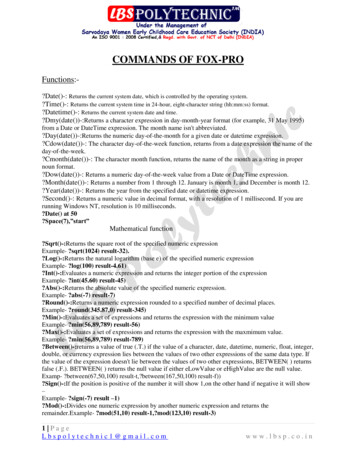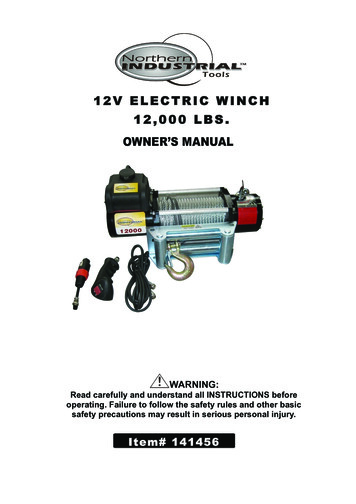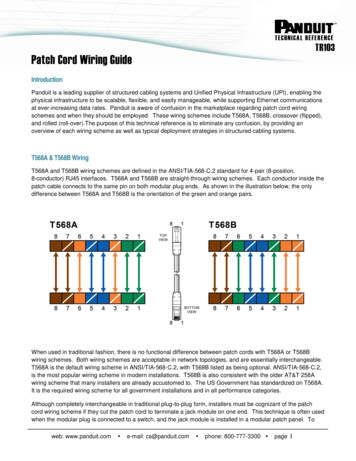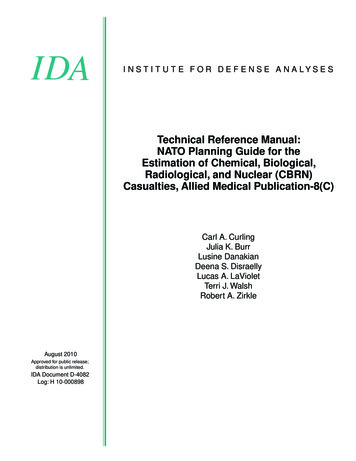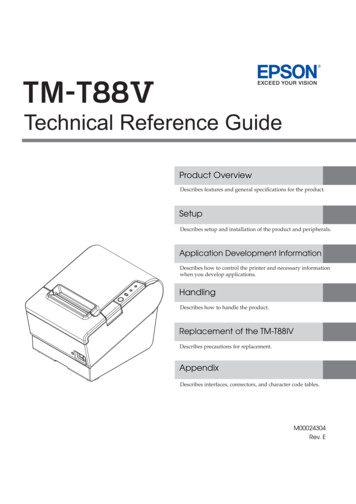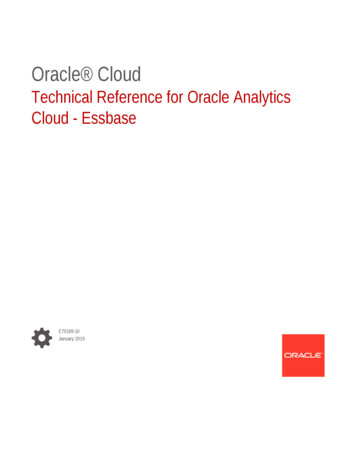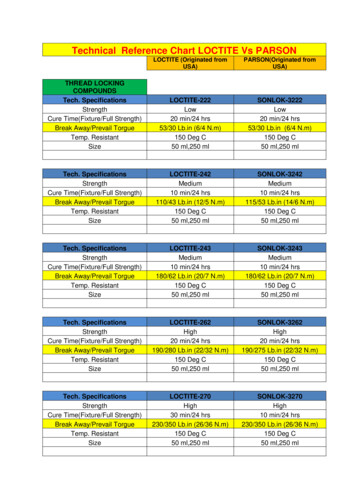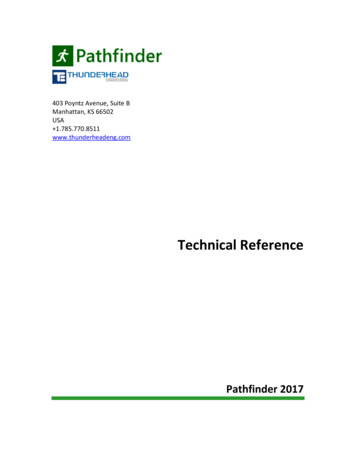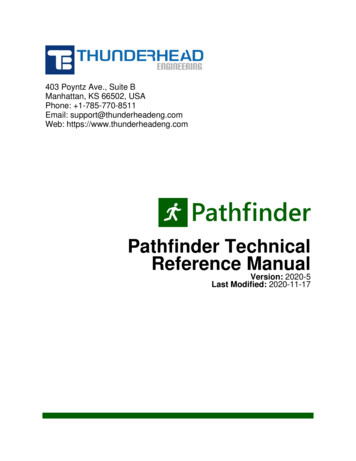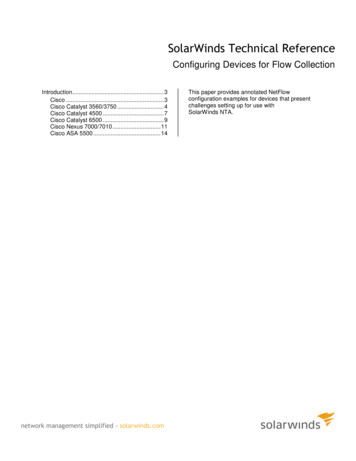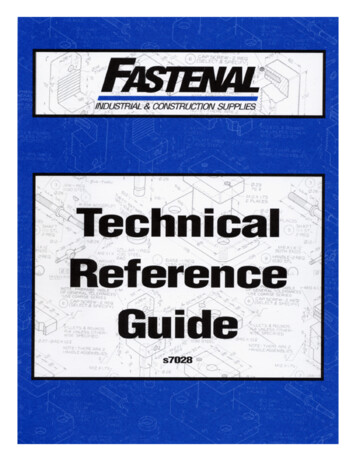
Transcription
Technical Reference GuideTable of ContentsSubjectFastener Material SelectionMechanical PropertiesMaterialsGallingHeat TreatmentScrew Thread FundamentalsStrength of ThreadsPlatings and CoatingsCorrosionHydrogen EmbrittlementHigh Temperature EffectsJoint DesignTension Control in a Bolted JointTorque ControlTorque and Turn ControlStretch ControlDirect Tension ControlReuse of FastenersStructural BoltsStandardsMetric SystemCommon Specifications for Use with FastenersAppendixPage r: The following information contains extracts, data, application examples, assembly and installation applications obtainedfrom industry standards/specifications that were represented as accurate at time of their publication. These standards/specifications areconstantly being updated and so the technical details are subject to revision. Fastenal strives to present the information in an accuratemanner, but we do not guarantee its completeness or validity. This information is subject to change at any time, without notice. TheFastenal Engineering Department welcomes questions regarding fastener specifications or specific customer applications, but anyinformation provided will be subject to this Disclaimer.The material provided in this guide is advisory only and use is completely voluntary. Fastenal makes no representations or warranties,express or implied, in connection with the information. Any use or application of this information will be at the users sole risk andresponsibility. Fastenal will not be responsible for any loss, claims or damages arising out of the use or application of thisinformation, regardless of whether the same may be known or foreseeable.Any questions, comments or concerns may be directed to the Fastenal Company Engineering Department at (507) 454-5374, or e-mailus at engineer@fastenal.comS7028Rev. 9Printed 9/13/2005
Fastener Material SelectionThere is no one fastener material that is right for every environment. Selecting the right fastener materialfrom the vast array of materials available can appear to be a daunting task. Careful consideration may needto be given to strength, temperature, corrosion, vibration, fatigue and many other variables. However, withsome basic knowledge and understanding, a well thought out evaluation can be made.Mechanical PropertiesMost fastener applications are designed to support or transmit some form of externally applied load. If thestrength of the fastener is the only concern, there is usually no need to look beyond carbon steel. Over90% of all fasteners are made of carbon steel. In general, considering the cost of raw materials, nonferrous should be considered only when a special application is required.Tensile StrengthThe most widely associated mechanical property associated with standard threaded fasteners is tensilestrength. Tensile strength is the maximum tension-applied load the fastener can support prior to orcoinciding with its fracture (see figure 1).Tensile load a fastener can withstand is determined by the formulaExample (see appendix for St and As values)P St x Aswhere3/4-10 x 7” SAE J429 Grade 5 HCSP tensile load (lb., N)St 120,000 psiAs 0.3340 sq. inSt tensile strength (psi, MPa)P 120,000 psi x 0.3340 sq. inAs tensile stress area (sq. in, sq. mm)P 40,080 lb.For this relationship, a significant consideration must be given to the definition of the tensile stress area,As. When a standard threaded fastener fails in pure tension, it typically fractures through the threadedportion (this is characteristically it’s smallest area). For this reason, the tensile stress area is calculatedthrough an empirical formula involving the nominal diameter of the fastener and the thread pitch. Tablesstating this area are provided for you in the appendix.Figure 1 Tensile Stress-Strain DiagramProof LoadThe proof load represents the usable strength range for certain standard fasteners. By definition, the proofload is an applied tensile load that the fastener must support without permanent deformation. In otherwords, the bolt returns to its original shape once the load is removed.Figure 1 illustrates a typical stress-strain relationship of a bolt as a tension load is applied. The steelpossesses a certain amount of elasticity as it is stretched. If the load is removed and the fastener is stillwithin the elastic range, the fastener will always return to its original shape. If, however, the load appliedcauses the fastener to be brought past its yield point, it now enters the plastic range. Here, the steel is nolonger able to return to its original shape if the load is removed. The yield strength is the point at whichpermanent elongation occurs. If we would continue to apply a load, we would reach a point of maximumstress known as the ultimate tensile strength. Past this point, the fastener continues to “neck” and elongate1
further with a reduction in stress. Additional stretching will ultimately cause the fastener to break at thetensile point.Shear StrengthShear strength is defined as the maximum load that can be supported prior to fracture, when applied at aright angle to the fastener’s axis. A load occurring in one transverse plane is known as single shear.Double shear is a load applied in two planes where the fastener could be cut into three pieces. Figure 2 isan example of double shear.For most standard threaded fasteners, shear strength is not a specification even though the fastener may becommonly used in shear applications. While shear testing of blind rivets is a well-standardized procedurewhich calls for a single shear test fixture, the testing technique of threaded fasteners is not as welldesigned. Most procedures use a double shear fixture, but variations in the test fixture designs cause awide scatter in measured shear strengths.To determine the shear strength of the material, the total cross-sectional area of the shear plane isimportant. For shear planes through the threads, we could use the equivalent tensile stress area (As).Figure 2 illustrates two possibilities for the applied shear load. One has the shear plane corresponding withthe threaded portion of the bolt. Since shear strength is directly related to the net sectional area, a smallerarea will result in lower bolt shear strength. To take full advantage of strength properties, the preferreddesign would be to position the full shank body in the shear planes as illustrated with the joint on the right.Figure 2 Shear Planes in a Bolted JointWhen no shear strength is given for common carbon steels with hardness up to 40 HRC, 60 % of theirultimate tensile strength is often used once given a suitable safety factor. This should only be used as anestimation.Fatigue StrengthA fastener subjected to repeated cyclic loads can suddenly and unexpectedly break, even if the loads arewell below the strength of the material. The fastener fails in fatigue. The fatigue strength is the maximumstress a fastener can withstand for a specified number of repeated cycles prior to its failure.Torsional StrengthTorsional strength is a load usually expressed in terms of torque, at which the fastener fails by beingtwisted off about its axis. Tapping screws and socket set screws require a torsional test.Other Mechanical PropertiesHardnessHardness is a measure of a material’s ability to resist abrasion and indentation. For carbon steels, Brinelland Rockwell hardness testing can be used to estimate tensile strength properties of the fastener.Ductility2
Ductility is a measure of the degree of plastic deformation that has been sustained at fracture. In otherwords, it is the ability of a material to deform before it fractures. A material that experiences very little orno plastic deformation upon fracture is considered brittle. A reasonable indication of a fastener’s ductilityis the ratio of its specified minimum yield strength to the minimum tensile strength. The lower this ratiothe more ductile the fastener will be.ToughnessToughness is defined as a material’s ability to absorb impact or shock loading. Impact strength toughnessis rarely a specification requirement. Besides various aerospace industry fasteners, ASTM A320Specification for Alloy Steel Bolting Materials for Low-Temperature Service is one of the fewspecifications that require impact testing on certain grades.MaterialsCarbon SteelOver 90% of fasteners manufactured use carbon steel. Steel has excellent workability, offers a broad rangeof attainable combinations of strength properties, and in comparison with other commonly used fastenermaterials, is less expensive.The mechanical properties are sensitive to the carbon content, which is normally less than 1.0%. Forfasteners, the more common steels are generally classified into three groups: low carbon, medium carbonand alloy steel.Low Carbon SteelsLow carbon steels generally contain less than 0.25% carbon and cannot be strengthened by heat-treating;strengthening may only be accomplished through cold working. The low carbon material is relatively softand weak, but has outstanding ductility and toughness; in addition, it is machinable, weldable and isrelatively inexpensive to produce. Typically, low carbon material has a yield strength of 40,000 psi, tensilestrengths between 60,000 and 80,000 psi and a ductility of 25% EL. The most commonly used chemicalanalyses include AISI 1006, 1008, 1016, 1018, 1021, and 1022.SAE J429 Grade 1, ASTM A307 Grade A are low carbon steel strength grades with essentially the sameproperties. ASTM A307 Grade B is a special low carbon steel grade of bolt used in piping and flangework. Its properties are very similar to Grade A except that it has added the requirement of a specifiedmaximum tensile strength. The reason for this is that to make sure that if a bolt is inadvertentlyovertightened during installation, it will fracture prior to breaking the cast iron flange, valve, pump, orexpensive length of pipe. SAE J429 Grade 2 is a low carbon steel strength grade that has improvedstrength characteristics due to cold working.Medium Carbon SteelsMedium carbon steels have carbon concentrations between about 0.25 and 0.60 wt. These steels may beheat treated by austenizing, quenching and then tempering to improve their mechanical properties. Theplain medium carbon steels have low hardenabilities and can be successfully heat-treated only in thinsections and with rapid quenching rates. This means that the end properties of the fastener are subject tosize effect. Notice on the SAE J429 Grade 5, ASTM A325 and ASTM A449 specifications that theirstrength properties “step down” as the diameters increase.On a strength-to-cost basis, the heat-treated medium carbon steels provide tremendous load carryingability. They also possess an extremely low yield to tensile strength ratio; making them very ductile. Thepopular chemical analyses include AISI 1030, 1035, 1038, and 1541.Alloy SteelsCarbon steel can be classified as an alloy steel when the manganese content exceeds 1.65%, when siliconor copper exceeds 0.60% or when chromium is less then 4%. Carbon steel can also be classified as analloy if a specified minimum content of aluminum, titanium, vanadium, nickel or any other element hasbeen added to achieve specific results. Additions of chromium, nickel and molybdenum improve thecapacity of the alloys to be heat treated, giving rise to a wide variety of strength to ductility combinations.3
SAE J429 Grade 8, ASTM A354 Grade BD, ASTM A490, ASTM A193 B7 are all common examples ofalloy steel fasteners.Stainless SteelStainless steel is a family of iron-based alloys that must contain at least 10.5% chromium. The presence ofchromium creates an invisible surface film that resists oxidation and makes the material “passive” orcorrosion resistant. Other elements, such as nickel or molybdenum are added to increase corrosionresistance, strength or heat resistance.Stainless steels can be simply and logically divided into three classes on the basis of their microstructure;austenitic, martensitic or ferritic. Each of these classes has specific properties and basic grade or “type.”Also, further alloy modifications can be made to alter the chemical composition to meet the needs ofdifferent corrosion conditions, temperature ranges, strength requirements, or to improve weldability,machinability, work hardening and formability.Austenitic stainless steels contain higher amounts of chromium and nickel than the other types. They arenot hardenable by heat treatment and offer a high degree of corrosion resistance. Primarily, they are nonmagnetic; however, some parts may become slightly magnetic after cold working. The tensile strength ofaustenitic stainless steel varies from 75,000 to 105,000 psi.18-8 Stainless steel is a type of austenitic stainless steel that contains approximately 18% chromium and8% nickel. Grades of stainless steel in the 18-8 series include, but not limited to; 302, 303, 304 and XM7.Common austenitic stainless steel grades: 302: General purpose stainless retains untarnished surface finish under most atmospheric conditionsand offers high strength at reasonably elevated temperatures. Commonly used for wire products suchas springs, screens, cables; common material for flat washers. 302HQ: Extra copper reduces work hardening during cold forming. Commonly used for machinescrews, metal screws and small nuts 303: Contains small amounts of sulfur for improved machinability and is often used for custom-madenuts and bolts. 304: Is a low carbon-higher chromium stainless steel with improved corrosion resistance whencompared to 302. 304 is the most popular stainless for hex head cap screws. It is used for coldheading and often for hot heading of large diameter or long bolts. 304L: Is a lower carbon content version of 304, and therefore contains slightly lower strengthcharacteristics. The low carbon content also increases the 304L corrosion resistance and weldingcapacity. 309 & 310: Are higher in b
SAE J429 Grade 8, ASTM A354 Grade BD, ASTM A490, ASTM A193 B7 are all common examples of alloy steel fasteners. Stainless Steel Stainless steel is a family of iron-based alloys that must contain at least 10.5% chromium. The presence of chromium creates an invisible surface film that resists oxidation and makes the material “passive” or corrosion resistant. Other elements, such as nickel or .
